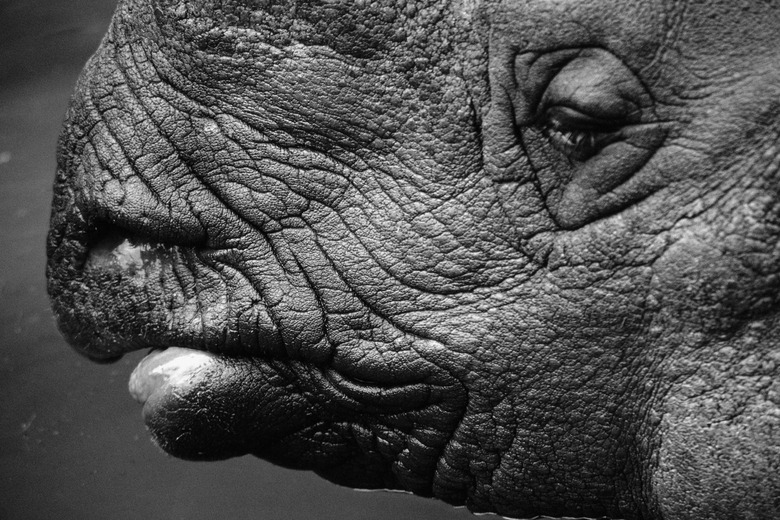Symbiotic Relationships For Rhinos
A symbiotic relationship between species may be beneficial to both species, making it mutualistic. Relationships between species that do not benefit both members, but do not harm either one, are commensal. When one species harms the other, the symbiosis is parasitic. Rhinoceroses experience notable examples of both mutualistic and parasitic relationships. Their digestion depends on microflora in the gut, for example. Also, they attract insect parasites, which in turn attract birds who eat the insects. The rhinoceros enjoys relief from the insects, while the birds enjoy a meal, but the relationships are not always so clear-cut.
Mutualistic Relationships in a Rhino's Gut
Mutualistic Relationships in a Rhino's Gut
Rhinoceroses are ungulates: hoofed animals with digestive systems similar to horses and elephants. They eat tough plant matter but are not able to digest the cellulose their food contains. They rely on microflora that are able to digest this material, releasing nutrients like fatty acids that the host animal can absorb and use for energy – an example of mutualism. The hosts don't ruminate like cattle; the microflora work in the host's hindgut. Studies of white rhino dung show bacteria of the phyla Firmicutes and Bacteroidetes dominating the microflora living in the rhino gut, along with many other unclassified bacteria.
A Symbiotic, but Parasitic, Relationship in a Rhino's Gut
A Symbiotic, but Parasitic, Relationship in a Rhino's Gut
The rhinoceros bot fly (Gyrostigma rhinocerontis) lives exclusively in the digestive tracts of both white and black rhinoceroses. The adults, which are the largest flies in Africa, lay their eggs on the skin of rhinos, and the larvae burrow into the rhino's stomach, where they attach and live through larval stages called "instars."
They emerge with the rhino's dung as larval "bots," then pupate and become adults. Then they have only a few days to find another rhinoceros host. This symbiotic relationship has no benefit to the rhino hosts, while the flies are "obligate parasites," which means they're dependent on the rhinos – they can't complete their life cycle without them.
Oxpecker and Rhino: A Highly Visible Example of Symbiosis
Oxpecker and Rhino: A Highly Visible Example of Symbiosis
Oxpecker birds (Buphagus erythrorhynchus), also called tickbirds, specialize in riding on large African animals, including rhinos and zebras, feeding on external parasites like the bot-fly larvae and ticks. The International Rhino Foundation describes how mynah birds serve the same role on rhinos in India. The oxpeckers feast on the parasites they find, and they also lend the favor of raising a loud warning when a potential predator approaches.
A Relationship Between Rhinos and Birds May Be Mutualistic or Parasitic
A Relationship Between Rhinos and Birds May Be Mutualistic or Parasitic
Researchers at the University of Zurich have documented parasitic behavior by red-billed oxbirds toward black rhinos in captivity at the Zoo Zürich. While the birds may hunt insects and ticks on their hosts – mutualistic behavior – they also peck at or create open wounds that can fester. They might eat loose dead skin, or peck at existing wounds to promote bleeding. The rhinos would attempt to remove these birds by swishing their tails or shaking their legs.
References
Cite This Article
MLA
Silbajoris, Alex. "Symbiotic Relationships For Rhinos" sciencing.com, https://www.sciencing.com/symbiotic-relationships-rhinos-8056591/. 20 July 2018.
APA
Silbajoris, Alex. (2018, July 20). Symbiotic Relationships For Rhinos. sciencing.com. Retrieved from https://www.sciencing.com/symbiotic-relationships-rhinos-8056591/
Chicago
Silbajoris, Alex. Symbiotic Relationships For Rhinos last modified March 24, 2022. https://www.sciencing.com/symbiotic-relationships-rhinos-8056591/
